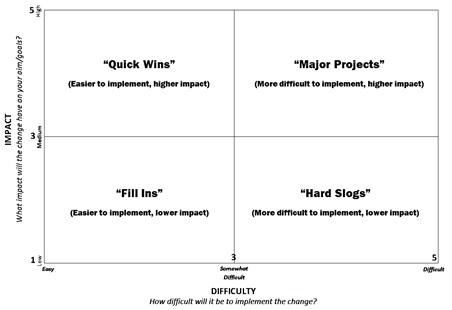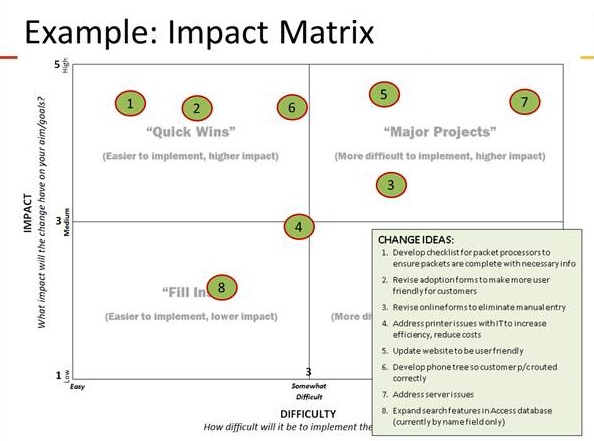QI Learning Center: Utilizing an Impact Matrix
- Details
- Last Updated on Tuesday, 08 September 2015 18:48
By: Jennifer Eastwood, MPH – Quality Assurance Specialist, Caswell County Health Department
Our QI Project Team has conducted a Gemba walk, a process of observing where the work is happening, and completed a value stream map to identify areas of waste. We've also taken it a step further by brainstorming improvement ideas that may help eliminate those wastes and posted a “starburst” (a star-shaped post it note with an improvement idea) for each change idea. By the end, we are enlightened! We are also completely overwhelmed and scared to death! Where do we even begin making all of these changes? How in the world are we going to get all of this done? Why do my team members' eyes look like they're glazed over? Maybe we've bitten off more than we can chew?
Change is a hard sell. When you start talking about specific changes, it can be daunting and you can see team members mentally backpedaling. Be strong and don't lose heart, there is a very easy tool that you can use that will make this process a lot less painful. The impact matrix is a tool that helps a team prioritize changes. It enables them to decide which solutions can have the most impact on the project's aim, with the least amount of difficulty/effort/cost. As I learned in the QI 101 and QI Advisor programs, it reveals what will give us the “biggest bang for our buck.”

First, create your matrix to look like the one above. Now, remember all of those improvement ideas (aka “Starbursts”)? Go back and number each one of them. Then, as your team discusses each starburst, rate it based on the level of impact and difficulty. What impact will the change have on your improvement aim? How difficult will it be to implement the change? Finally, graph the numbers for each starburst on the impact matrix (as shown below). Focus on the starbursts that fall into the “Quick Wins” quadrant. You will find that focusing on these gives your team a sense of accomplishment and will build their confidence as they learn this QI process. It may make them more eager and willing to take one harder improvement ideas.

I will confess that I tend to be methodical about the QI Process. And, in the QI Process the impact matrix follows the value stream map. This morning, however, I had an “aha moment” concerning the use of this tool. Our health department is currently conducting our Community Health Assessment as we are required by the state to do every four years. As I said before, change is a hard sell and becomes even more difficult when you have to change the way an entire county eats, exercises, or accesses medical care. At this stage of the process we are up to our elbows in primary and secondary data and trying to make some sense out of the information so that we can prioritize our health issues and determine our focus for the next four years. Today, as I was thinking about how to go about this it occurred to me that an impact matrix doesn't have to follow a value stream map and that's the only time we use it. It can be used anytime we have decisions to make about the activities we pursue on a strategic level with the limited resources we are given.


